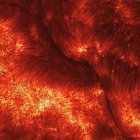|
Science and Astronomy Questions
|
|
| Solaris | Date: Saturday, 16.06.2012, 23:14 | Message # 46 |
 World Builder
Group: Global Moderators
 France
France
Messages: 731
Status: Offline
| I've always wondered, why there is a temperature minimum but no maximum temperature (for all I know)? you can not go below -273.15 ° C because "nothing moves anymore". how it works there in the opposite case, Is There a limit too?
|
| |
| |
| HarbingerDawn | Date: Saturday, 16.06.2012, 23:46 | Message # 47 |
 Cosmic Curator
Group: Administrators
 United States
United States
Messages: 8717
Status: Offline
| Quote (Solaris) I've always wondered, why there is a temperature minimum but no maximum temperature
There is a minimum temperature because there is a lowest possible energy that particles can have (a slowest speed that they can move). But there is no clear upper limit to how energetic particles can be since they can always move closer to the speed of light. So you can always have a more energetic system. There are limits in certain cases. For example, when particles have a lot of energy (high temperature) then electrons will break free from atoms. This is why things turn into plasma at very high temperatures; the atoms become ionized. Perhaps it is possible that at extremely high temperatures that even nuclear bonds might break, perhaps even quarks could come apart from each other, but if this is possible it would likely require temperatures of trillions of Kelvins. I am simply speculating here since I don't know much about this. But even if certain types of matter cannot exist beyond certain temperatures, you can still have higher temperatures where that matter's constituent components gain even more energy.
All forum users, please read this!
My SE mods and addons
Phenom II X6 1090T 3.2 GHz, 16 GB DDR3 RAM, GTX 970 3584 MB VRAM
|
| |
| |
| apenpaap | Date: Sunday, 17.06.2012, 00:48 | Message # 48 |
 World Builder
Group: Users
 Antarctica
Antarctica
Messages: 1063
Status: Offline
| There's a minumum temperature because at this point, there is no heat left; the particles matter consists of stand still at 0 Kelvin, and therefore can't move even slower. But there is no maximum limit to their speed: while light speed may sound like it would cause a maximum temperature, stuff gets more massive when it reaches speeds close to light speed. If something with a higher mass moves at the same speed as something with a lower mass, there's more energy in the movement of the thing with the higher mass. Since the mass goes up quicker and quicker (theoretically reaching infinite mass at light speed), while there is a limit to the speed a particle can move with, there's no limit to the energy it can hold. And therefore, no upper limit to temperature. At least, that's what I think.
EDIT: This seems to be my one hundredth post here! 
I occasionally stream at http://www.twitch.tv/magistermystax. Sometimes SE, sometimes other games.
Edited by apenpaap - Sunday, 17.06.2012, 02:24 |
| |
| |
| architeuthis | Date: Sunday, 17.06.2012, 01:53 | Message # 49 |
 Space Tourist
Group: Users
 United States
United States
Messages: 21
Status: Offline
| Quote (Hardts) - Q1: Is there any place in the cosmos we know of where the temperature is lower than 0 K ?
No. Nothing is colder than absolute zero.
Quote (Hardts) - Q2: Is it possible to have liquid water below 0 C (excluding water current as a factor), and would atm. pressure have any say in this ?
Yes its totally possible. The freezing point of water 0 C is defined for 1 atm. At higher or lower pressures, freezing and boiling points are different. You can refer to a phase diagram for water to see at which pressures water remains liquid below 0 C.
Quote (Hardts) - Q3: how would you calculate the terminal velocity of a spherical object (to simplify), given you have 'g' (gravity) and atmospheric pressure ? Can we (or is this perhaps the only option) ignore the makings of a given atmosphere (ie. procentage of different gasses) and just consider density as a multiplier to increasing friction? - How would we go about doing this calculation biggrin ?
Terminal velocity is the point at which acceleration due to gravity is equal to acceleration due to drag. On earth acceleration due to gravity is 9.8 m/s^2, the equation for drag force is D=1/2CpAv^2 where C is the drag coefficient, p is fluid density (of air usually, though it is possible to consider terminal velocity of a neutrally buoyant object in any kind of fluid), A is cross-sectional area, and v^2 is velocity squared.
EDIT: Opps. I was replying to an old post 
Edited by architeuthis - Sunday, 17.06.2012, 01:56 |
| |
| |
| Talisman | Date: Sunday, 17.06.2012, 06:05 | Message # 50 |
 Pioneer
Group: Users
 United States
United States
Messages: 409
Status: Offline
| Isn't the maximum temperature possible theoretically where the particles are moving at 99.99% the speed of light?
EDIT: Ah, I thought that was the planck temperature.

Edited by Talisman - Monday, 18.06.2012, 07:22 |
| |
| |
| apenpaap | Date: Sunday, 17.06.2012, 10:16 | Message # 51 |
 World Builder
Group: Users
 Antarctica
Antarctica
Messages: 1063
Status: Offline
| No. Because by then, the particles will be incredibly massive, and even a very minor speedup (to 99.990001% of the speed of light, for example) will have an enormous effect. It takes infinite energy to reach light speed (which is why it's the maximum speed of stuff), and therefore a particle (or anything else, for that manner) can always get more energy into it.
I occasionally stream at http://www.twitch.tv/magistermystax. Sometimes SE, sometimes other games.
|
| |
| |
| SpaceEngineer | Date: Sunday, 17.06.2012, 13:19 | Message # 52 |
 Author of Space Engine
Group: Administrators
 Russian Federation
Russian Federation
Messages: 4800
Status: Offline
| The maximum temperature that current physics can operate is the Planck temperature Tp = 1.4 x 1032 K. At this temperature the energy of particles is close to the Planck energy and all interactions (electromagnetic, nuclear, weak and gravity forces) will merge together. This is a limit for quantum physics because we have no theory of quantum gravity and can't describe what happens above such energy.
http://en.wikipedia.org/wiki/Planck_temperature
*

|
| |
| |
| HarbingerDawn | Date: Sunday, 17.06.2012, 13:25 | Message # 53 |
 Cosmic Curator
Group: Administrators
 United States
United States
Messages: 8717
Status: Offline
| Quote (Talisman) Isn't the maximum temperature possible theoretically where the particles are moving at 99.99% the speed of light?
There is no limit to how close something can get to the speed of light, so there is no limit to the amount of energy it could theoretically contain. In practice though, you need energy to accelerate matter, so the maximum speed is defined by the total energy content of the universe, and the mass of the smallest particle. I would post an equation, but I'm not up to speed on my Relativity 
All forum users, please read this!
My SE mods and addons
Phenom II X6 1090T 3.2 GHz, 16 GB DDR3 RAM, GTX 970 3584 MB VRAM
|
| |
| |
| Neon | Date: Tuesday, 21.08.2012, 05:00 | Message # 54 |
|
Explorer
Group: SE team
 Australia
Australia
Messages: 208
Status: Offline
| Quote (Hardts) This is the perfect thread for my boatload of astronomy and physics questions smile For now, I just have a few;
- Q1: Is there any place in the cosmos we know of where the temperature is lower than 0 K ?
- Q2: Is it possible to have liquid water below 0 C (excluding water current as a factor), and would atm. pressure have any say in this ?
- Q3: how would you calculate the terminal velocity of a spherical object (to simplify), given you have 'g' (gravity) and atmospheric pressure ? Can we (or is this perhaps the only option) ignore the makings of a given atmosphere (ie. procentage of different gasses) and just consider density as a multiplier to increasing friction? - How would we go about doing this calculation biggrin ?
Sorry for messyness of the question wink .
1, No, nothing can be colder than 0K, it is the the state at which all motion of all things
stop. Not even an aton moves anymore. Remember, temperature is a measure
of the motion of particles in a volume. Faster they move, the higher the
temperature.
2. Yes, it is called Super Chilled water. It occurs in the Atmosphere of earth
all the time. It will usually remain stable unless a grain of dust, or an
aircraft passing disturbs it, at which time it will instantly freeze. For
pilots, this is what causes Icing of aircraft wings/ propellers and other
essential parts of an aircraft.
3. Have a read of this, n you'll better understand this, and find how to calculate it. 
Wiki on Calculating Terminal Velocity
Neon
|
| |
| |
| neutronium76 | Date: Wednesday, 12.09.2012, 21:37 | Message # 55 |
 World Builder
Group: Users
 Greece
Greece
Messages: 718
Status: Offline
| Ok so here is another stupid, noob question from a retarded but lover of astronomy:
Suppose You are in your spaceship and you are travelling with, say 20 km/sec in relation to the sun and towards it. What is the speed of the photons and other cosmic particles that are being emmited from the sun and are travelling outwards towards you?
No laugh please 
PC1:Core i7 970@3.34GHz, 6 cores/12 threads, 12GB DDR3 RAM@1.34GHz, 2x(SLI) GTX-580 GPUs 3GB VRAM(GDDR5)@1GHz, OS:Win7x64SP1
PC2:Core2Quad X9770@3.2GHz, 2 cores/4 threads 4GB DDR2 RAM@1GHz, GTX-285 GPU 1GB VRAM(DDR3)@1.24GHz, OS:WinVistax64SP2
|
| |
| |
| HarbingerDawn | Date: Wednesday, 12.09.2012, 21:47 | Message # 56 |
 Cosmic Curator
Group: Administrators
 United States
United States
Messages: 8717
Status: Offline
| Quote (HarbingerDawn) What is the speed of the photons and other cosmic particles that are being emmited from the sun and are travelling outwards towards you?
299 792 458 m/s  (for the photons) (for the photons)
The speed of light is always constant. Every observer will measure the speed of light in a vacuum at exactly that same speed, regardless of his/her movement relative to any source of photons. But as you move towards a source of photons, the wavelength of the photons will decrease (they become bluer, more energetic).
Think of it like this: if you move towards something that is moving towards you, the potential energy between you increases. Usually this is because of an increase in kinetic energy, due to velocity. But the velocity of light is constant, it never changes. But the energy between you and the photons must still increase as you speed towards them, so instead of increasing in kinetic energy (which they can't do), the photons get shorter in wavelength (blue-shift).
The other cosmic particles will mostly seem to be moving 20 km/s faster since they are not moving close to the speed of light.
Make sense?
All forum users, please read this!
My SE mods and addons
Phenom II X6 1090T 3.2 GHz, 16 GB DDR3 RAM, GTX 970 3584 MB VRAM
Edited by HarbingerDawn - Wednesday, 12.09.2012, 21:49 |
| |
| |
| neutronium76 | Date: Wednesday, 12.09.2012, 22:47 | Message # 57 |
 World Builder
Group: Users
 Greece
Greece
Messages: 718
Status: Offline
| So the faster you move towars a light source, the shorter the wavelength o f the visible light that hits you from that source? so if you are travelling close to the speed of light everything will move to the UV section of the spectrum and you will see light as blue/violet?
PC1:Core i7 970@3.34GHz, 6 cores/12 threads, 12GB DDR3 RAM@1.34GHz, 2x(SLI) GTX-580 GPUs 3GB VRAM(GDDR5)@1GHz, OS:Win7x64SP1
PC2:Core2Quad X9770@3.2GHz, 2 cores/4 threads 4GB DDR2 RAM@1GHz, GTX-285 GPU 1GB VRAM(DDR3)@1.24GHz, OS:WinVistax64SP2
|
| |
| |
| apenpaap | Date: Wednesday, 12.09.2012, 22:54 | Message # 58 |
 World Builder
Group: Users
 Antarctica
Antarctica
Messages: 1063
Status: Offline
| Yes. It's called redshift and blueshift, and it's most well-known with regards to galaxies: the nearby ones are blueshifted because gravity causes us to come closer to each other, but further away ones are redshifted due to the expansion of the universe making us move apart. And galaxies really far away are redshifted an awful lot. If you moved very fast, the visible light would indeed be shifted to UV (though this doesn't mean everything will neccessarily be blue, as infrared will shift into our visible spectra).
I occasionally stream at http://www.twitch.tv/magistermystax. Sometimes SE, sometimes other games.
|
| |
| |
| neutronium76 | Date: Tuesday, 25.09.2012, 17:17 | Message # 59 |
 World Builder
Group: Users
 Greece
Greece
Messages: 718
Status: Offline
| I recently watched Prometheus and I have a question regarding its speed: In the movie the distance of the star system they were travelling to was 34.5 LYs and they experienced it as a 2 years, 4 months, 18 days, 36 (ship) hours. (=2.38 years) travel time. If we take into account the fact that they weren't travelling faster than light and that this time was due to time dilation/compression, what was the speed they were traveling at? I tried this site: http://www.prometheus-movie.com/community/forums/topic/7753 and scroll down to the middle of the page where a guy called ''relative'' computed its speed to be 0.9976256066302674 the speed of light. What equeation did he use to calculate this?
PC1:Core i7 970@3.34GHz, 6 cores/12 threads, 12GB DDR3 RAM@1.34GHz, 2x(SLI) GTX-580 GPUs 3GB VRAM(GDDR5)@1GHz, OS:Win7x64SP1
PC2:Core2Quad X9770@3.2GHz, 2 cores/4 threads 4GB DDR2 RAM@1GHz, GTX-285 GPU 1GB VRAM(DDR3)@1.24GHz, OS:WinVistax64SP2
|
| |
| |
| Aerospacefag | Date: Tuesday, 25.09.2012, 17:36 | Message # 60 |
 Pioneer
Group: Users
 Russian Federation
Russian Federation
Messages: 401
Status: Offline
| Quote (neutronium76) What equeation did he use to calculate this?
The one that is not from the Hollywood. You can't fly faster then speed of light when you're slower then a speed of light.
Quote (neutronium76) 2 years, 4 months, 18 days, 36 (ship) hours
The reason is, that this is their observable speed (from the point of destination), which is 34,5 LY away. They might seem to be traveling faster than speed of light, but this isn't true for all observers. From the Earth it most likely would be about 69 years, and for the ship itself it's 34,5 years.
For reference see "relativity of simultaneity". However, I allow the possibility of misunderstanding on my side.
>converts km to miles to calculate speed

Edited by Aerospacefag - Tuesday, 25.09.2012, 17:55 |
| |
| |